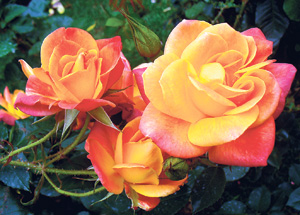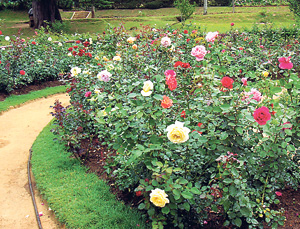Vivid colours and sweet fragrances to keep any visitor spellbound. Come April, the Hakgala Rose Garden in all its glory entrances all and sundry.
The process of bringing the rose garden alive with over 100 varieties of roses displaying their beauty for the April season starts in the second week of January and is the result of careful planning and dedicated efforts by Hakgala Botanical Gardens staff.
Around January 15, the Curator of the Hakgala Botanical Gardens, M.M.D.J. Senaratne closes the rose garden to visitors and orders the trimming of the plants. Known as hard-pruning, all rose stems are cut, leaving only a length of about 1-2 feet above the ground.
This is to strengthen the roots and stimulate the plant to produce new, strong canes for the roses to bloom in time for the season. Sometimes the plants are temporarily removed from the soil to cut off the dead roots while the soil of the rose-bed is treated with a mixture of cow dung, compost and lime.
About three weeks after pruning, the labourers reshuffle the soil to provide a good air supply to the roots. The reshuffling also helps release the heat that the cow-dung, compost and lime mix generates.
After a month, a mix of nitrogen, potassium and phosphorus is introduced to the soil to provide nutrients to the plants while some of the rose-buds that appear before April are removed to stop the plants becoming weak.
The first roses of Hakgala which bloom in the first week of April are offered to the Dalada Maligawa with the Curator himself taking the bunch for the pooja in thanksgiving for the success of the pruning as well as to get blessings for the season ahead, making it unique ritual of the Hakgala Gardens.
Twenty per cent of the roses at Hakgala start flowering on April 1, with the rose garden attaining full bloom by mid-April at the height of the Nuwara Eliya season.
“Some visitors may wonder whether we are using hormones to get the plants to flower during the season. We never do and even try not to use agro-chemicals,” said Mr. Senaratne, explaining that even pesticides are used only as a last resort. The bugs that eat roses are usually hand removed.
A set of mother plants is maintained in the nursery in case a plant needs to be replaced and new plants are created by grafting the stems from these plants, with budder G.H.W. Jayatissa tending them carefully as he has been doing for over 28 years.
The rose garden is what it is due to the efforts of S.B. Tennakoon, Curator of the Hakgala Botanical Gardens in the1960s, who imported the mother plants from England through the British High Commission while designing the new rose garden, it is learnt.
The rose garden was initially designed as a wall clock with its fence made of endemic Rhododendron (ma rath mal) wood. But since maintenance needed lots of these endemic and rare Rhododendron trees to be cut, a chain fence was erected later, recalls the Director-General of the Department of National Botanic Gardens, Dr. Siril Wijesundara who was Hakgala’s Curator in the early 1980s.
Even though visitors may not see roses in January, February or March, it is still beautiful. Dr. Wijesundara recalls how a film crew came in the 1980s at the wrong time to record a song-scene with actress Geetha Kumarasinghe before a backdrop of roses for ‘Salambaka Handuwa’. Initially the crew was disappointed, but the director found the flowerless rose garden beautiful enough to do the shooting.
As many as 6,000 - 8,000 enjoy the beauty of the rose garden per day on a busy weekend during the season.
Look at the roses, but don’t pluck them or break the stems, is the plea of the workers of Hakgala who tirelessly labour to bring about this wonder.
Ravana’s pleasure garden is 149 years
Legend has it that Hakgala was King Ravana’s pleasure garden where he kept the beautiful Princess Sita whom he had abducted from India. Today the famous Botanical Gardens is located in the same area along the Badulla Road, 9.5 km south-east of Nuwara Eliya.
Hakgala is Sri Lanka’s second Botanical Gardens established in 1861 for the experimentation and promotion of Cinchona by Dr. G.H.K. Thwaites who was then Director of the Peradeniya Botanical Gardens.
Hakgala was selected because of the similarity of climate and topography of the Andean Mountains in Peru, home of wild Cinchona. Situated at an elevation of about 1745 m above sea level, the Hakgala Botanical Gardens is about 28 hectares in extent. |



